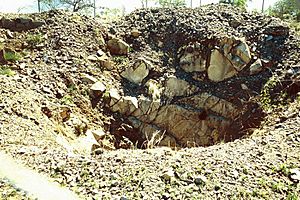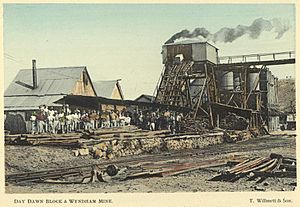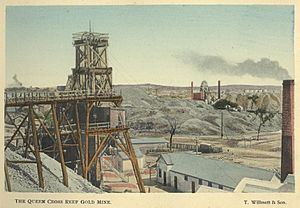Charters Towers mine shafts facts for kids
Quick facts for kids Charters Towers mine shafts |
|
|---|---|

Charters Towers gold mine shaft remains, 2001
|
|
| Location | Charters Towers, Charters Towers Region, Queensland, Australia |
| Design period | 1870s - 1890s (late 19th century) |
| Built | 1883 - 1916 |
| Official name: Charters Towers Gold Mine Shafts and Remains | |
| Type | state heritage (archaeological) |
| Designated | 29 April 2003 |
| Reference no. | 602221 |
| Significant period | 1883-1916 (fabric, historical) |
| Significant components | shaft, mounting block/stand, mullock heap, slab/s - concrete |
| Lua error in Module:Location_map at line 420: attempt to index field 'wikibase' (a nil value). | |
The Charters Towers mine shafts are a special group of old mine shafts and ruins. They are located in Charters Towers, Queensland, Australia. These shafts were built between 1883 and 1916. They are now protected as a heritage site, added to the Queensland Heritage Register in 2003.
Contents
History of Gold Mining
These eight mine shafts are found right among the streets of Charters Towers. They were built during a time when gold mining was very busy, from 1872 to 1917. During these 45 years, Charters Towers became one of the most important goldfields in Queensland and even in Australia. Many companies from overseas invested a lot of money here.
At its busiest, Charters Towers produced more than a third of all the gold in Queensland! This success helped the town of Charters Towers grow and stay strong. It also had a big impact on how North Queensland developed and on Queensland's economy.
How Gold Was Found
Gold was first found near Towers Hill in late 1871. By August 1872, the Charters Towers Goldfield was officially opened. There wasn't much gold on the surface here. Most of the valuable gold was found deep underground in sloping rock layers called "reefs."
Miners had to dig deep shafts to reach these gold-rich reefs. Sometimes they dug vertical shafts straight down. Other times, they dug "underlie shafts" that followed the angle of the gold reef. It's amazing to think that there are about 200 kilometers (124 miles) of mine shafts under Charters Towers!
Because the gold was deep underground, it cost a lot of money and needed special equipment to get it out. This type of mining led to more permanent towns, unlike some gold rush towns that appeared and disappeared quickly.
The Gold Rush Boom
Mining companies took out leases (permission to mine) all over Charters Towers. They often dug several shafts on their land to find the gold reefs. Sometimes they found nothing, but other times they had huge successes!
A very rich period began in 1878 when the amazing Day Dawn Reef was discovered. This reef became one of the biggest gold producers in Charters Towers. The town boomed throughout the 1880s, becoming much more important than other mining towns in North Queensland.
In 1885, Charters Towers gold was shown at an exhibition in London. This led to British investors pouring money into the town from 1886. This money helped build the city and keep the large-scale mining going.
By 1886, 33 shafts were dug deeper than 152 meters (500 feet). Gold production had doubled since 1883. In 1889, the famous Brilliant Reef was found. This was the richest reef on the field! Charters Towers continued to do well even when the economy was tough in the 1890s.
Gold production peaked in 1899, with over 319,572 ounces (about 9,000 kg) of gold. The town's population also reached its highest point, with about 27,000 people in 1900. Charters Towers was so confident then that people called it "The World." No other mining town in North Queensland was as successful or diverse.
The Decline of Gold Mining
In the early 1900s, gold production slowly started to drop. By 1910, the number of miners working in Charters Towers fell sharply. The government tried to help some mines with money for more exploration, but it didn't find much new gold. People started to leave Charters Towers.
Most mines were closed by 1916. The last big mine, the Brilliant Extended, shut down in 1917. By the end of this gold mining era, Charters Towers Goldfield had produced about 7 million ounces of gold.
During World War I, much of the mining equipment, like headframes (the structures over the mine shafts) and machinery, was taken apart. The metal was recycled to help with the war effort. Sometimes, the equipment was just moved to newer mines.
In the 1960s, the Charters Towers City Council put fences around the remaining mine shafts to keep people safe. In recent years, many old mine shafts have been capped (covered). The Department of Natural Resources and Mines still looks after these mine shafts today.
Important Mine Shafts
Many mines operated in Charters Towers. Here are some of the most important shafts that remain today:
Day Dawn Block and Wyndham
The Day Dawn Block and Wyndham Company worked three shafts on the Day Dawn reef. They mined continuously from 1883 to 1912. This was one of the three biggest mines on the Day Dawn lode. It produced the most gold of any mine in Charters Towers. It yielded over 546,531 ounces (about 15,500 kg) of gold!
The company was formed in 1882. Their No. 1 shaft hit the Day Dawn reef at 145 meters (475 feet) deep in 1883. People were very excited about how much gold they found there. By 1897, the No.1 shaft was no longer used.
The No. 3 shaft was a vertical shaft that went down 170 meters (560 feet). From there, an underlie shaft followed the gold lode even deeper. In 1886, a British company bought the mine. By 1900, the company employed 225 men. The mine closed in 1912.
Day Dawn Block and Wyndham No 1 Shaft
This shaft is on vacant land near Upper Deane Street. It has a safety fence around it. The shaft opening is about 3 meters (10 feet) wide. There are no other mine remains here, but you can still see where a tramway used to connect this shaft to the main railway lines.
Day Dawn Block and Wyndham No 3 Shaft
This shaft, along with old machinery foundations and piles of waste rock (mullock heaps), is on vacant land near Stubley Street. It is also fenced for safety. The vertical shaft is said to be 173 meters (568 feet) deep. Inside the fence, you can see parts of the old headframe (the structure that stood over the shaft). There are also large concrete and brick foundations from the machinery that used to be here.
Day Dawn Freehold Extended
This shaft was part of the Day Dawn Freehold Extended Mine. It was dug at the western end of the Day Dawn reef. In 1898, it was 329 meters (1,079 feet) deep.
The Day Dawn Freehold Extended Gold Mining Company started around 1896-97. They dug a shaft that hit the Day Dawn reef at 335 meters (1,100 feet). The mine closed in 1911.
Day Dawn Freehold Extended Shaft
This vertical shaft is at the southern end of Oxford Street. It is open and well-defined, with a safety fence around it. The shaft entrance is very wide. It is said to be 361 meters (1,185 feet) deep. You can see three concrete footings that held up the headframe. Across a dirt track, there are also concrete and brick remains of a settling pond.
Plant's Day Dawn
Plant's Day Dawn Gold Mines Ltd owned land north of the Day Dawn Block and Wyndham mine. In 1902, a deep shaft was dug to reach the Day Dawn reef. By 1906, the shaft was 366 meters (1,200 feet) deep, and then work stopped.
This shaft is connected to Edmund Plant, a very important mining leader in Charters Towers. He helped build the Venus Battery (a place where gold was processed) and Thornburgh House. He made a big difference to the mining industry and life in Charters Towers.
Plant's Day Dawn Shaft
This shaft is near Marion and Oxford Streets. It has a fence around it and some small concrete foundations nearby. The shaft itself has a concrete cover.
Brilliant Deeps
The discovery of the Brilliant Reef was a huge event for Charters Towers. It helped the goldfield survive during a tough economic time in the 1890s. Many mines were started to get gold from the Brilliant Reef.
The Brilliant Deeps shaft was dug in 1891. It was a three-part vertical shaft that went over 610 meters (2,000 feet) deep. An explosion on Christmas Day 1896 damaged the shaft, putting 30 men out of work. No valuable gold was found, and operations stopped in 1904.
Later, in 1907, the company started again as Brilliant Deeps Ltd. They found more success when they hit a new reef. From 1908 to 1916, this mine produced over 22,843 ounces (about 647 kg) of gold. The Brilliant Deeps was the deepest vertical mine shaft in Charters Towers.
Today, a new mining company is digging right next to this old shaft, hoping to find more gold in the Brilliant Reef.
Brilliant Deeps Shaft
This shaft and the foundations of its surface buildings are between Anne and Park Streets. The shaft is open and clearly defined, going down 778 meters (2,552 feet). It is surrounded by a safety fence. There are also large concrete and brick remains of machinery foundations.
Queen Cross Extended
While many mines were slowing down after 1900, a new rich discovery was made in 1902: the New Queen Cross Reef. The shaft for the Queen Cross Extended Mine was dug around 1905. It didn't produce much gold and closed soon after.
Queen Cross Extended Shaft
This mine shaft and its brick machinery foundations are on vacant land at the top of Gladstone Road. The shaft is wide and enclosed by a safety fence. Directly opposite the shaft are the small brick foundations of the mine machinery.
New Queen Central
The New Queen Central Mining Company operated from 1892 to 1916 but didn't have much success. They dug two vertical shafts. Even though other mines nearby found rich gold, very little gold was found on this company's land.
The No. 2 shaft went down 579 meters (1,900 feet). By 1916, the mine had produced 8,157 ounces (about 231 kg) of gold. The mine closed in June 1916.
New Queen Central Shaft
This shaft and its remaining buildings are on vacant land near Sayers Street. The shaft is open and clearly defined, with a safety fence around it. It goes down 579 meters (1,900 feet). You can see two footings (bases) for the poppet head (a structure over the shaft) outside the fence. There are also remains of brick and concrete machinery foundations.
St George and Moonstone
This shaft was dug in 1915. The government helped pay for it, hoping it would hit the Moonstone reef at 243 meters (798 feet) deep. The Moonstone reef was one of the first to be mined in Charters Towers back in 1872. However, the search for gold in 1915 was not successful, and the mine closed.
St George and Moonstone Shaft
This shaft is on the southern side of Towers Hill. It is open and clearly defined, with a safety fence around it. The shaft opening is about 6 by 4 meters (20 by 13 feet) wide and is filled with water. Inside the fence, you can see parts of a headframe footing. Outside the fence, there are some small piles of waste rock.
Why These Sites Are Important
The Charters Towers Mine Shafts were added to the Queensland Heritage Register in 2003 because they are very important for several reasons:
- Showing History: These mine shafts and their remains show how the mining industry grew in Queensland. They remind us of the huge gold mining activity in Charters Towers from 1872 to 1917. This made Charters Towers the second-largest city in Queensland at that time and the third-largest goldfield in Australia. The gold from Charters Towers greatly helped Queensland's economy and the way North Queensland was settled.
- Rare Heritage: Hundreds of mines were active in Charters Towers during its peak. These eight mine shafts and their remains are some of the few physical reminders left of that massive mining activity. They are a rare link to a time when mining had a huge impact on Queensland's development.
- Learning from the Past: These mine shafts, the remaining building foundations, and the land around them can teach us a lot about what mining was like in Charters Towers from 1872 to 1917. As a group, these sites help us understand how the town of Charters Towers grew right in the middle of huge gold mining operations.
- Good Examples: The eight mine shafts and the remaining buildings around them are excellent examples of deep reef gold mines and vertical shafts from that period.
Images for kids






